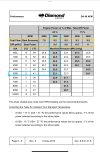JackFliesGA
Filing Flight Plan
- Joined
- Aug 29, 2023
- Messages
- 23
- Display Name
Display name:
Jack L.
I’m trying to do some fuel calc for my first cross country in a DA40 with a constant prop and mixture + prop speed + throttle controls.
From my fixed prop training, I had associated a specific RPM with a fuel flow.
But this chart seems to suggest that you can get different flow rates at the same RPM setting in a certain percent-of-takeoff-power?
How do I know which flow to use?
Example:
At 5000’ MSL, at standard temps, to get 65% Takeoff Power, I need to 2200 RPMs at 23.1 inhg manifold pressure. But what fuel flow is that??

From my fixed prop training, I had associated a specific RPM with a fuel flow.
But this chart seems to suggest that you can get different flow rates at the same RPM setting in a certain percent-of-takeoff-power?
How do I know which flow to use?
Example:
At 5000’ MSL, at standard temps, to get 65% Takeoff Power, I need to 2200 RPMs at 23.1 inhg manifold pressure. But what fuel flow is that??

